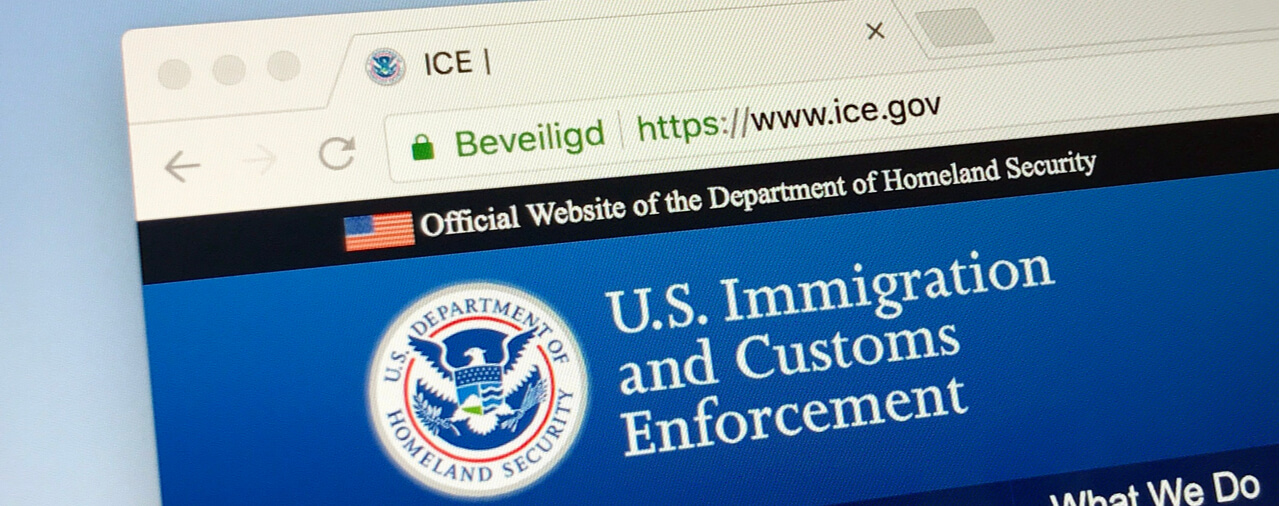On February 18, 2021, the acting Director of the U.S. Immigration and Customs Enforcement (ICE), published a memorandum titled “Interim Guidance: Civil Immigration Enforcement and Removal Priorities [link].” This guidance outlines new civil enforcement priorities for immigration in the wake of the acting Director of Homeland Security’s rescission of the prior civil enforcement priorities [see article] that had been solidified in a February 2017 memorandum. The February 18, 2021 guidelines will remain in place only until the Secretary of Homeland Security implements new civil enforcement priorities in consultation with ICE. Below, we will examine the February 18, 2021, ICE enforcement priorities.
Background of the Interim Enforcement Priorities
On January 20, 2021, President Joe Biden issued Executive Order 13993, Revision of Civil Immigration Enforcement Priorities and Policies. Based on President Biden’s order, the then-acting Secretary of Homeland Security issued an interim memorandum, which we discussed in a prior post [see article]. The memorandum established a review of DHS’s enforcement priorities, set forth temporary enforcement priorities pending completion of that review, and imposed a 100-day pause on most removals during the review period. The 100-day pause on removals was subsequently blocked via a temporary restraining order entered by the United States District Court for the Southern District of Texas, and that injunction remains in place. These events provide the background context for ICE’s temporary enforcement priorities during the DHS’s review period.
When Do the Civil Enforcement Priorities Apply?
ICE will refer to the new civil enforcement priorities in the following situations:
previously issued detainer;
Deciding whether to issue, reissue, serve, file or cancel a Notice to Appear;
Deciding whether to focus resources only on administrative violations or conduct;
Deciding whether to stop, question, or arrest a noncitizen for an administrative violation of the civil immigration laws;
Deciding whether to detain or release from custody subject to conditions;
Deciding whether to grant deferred action or parole; and
Deciding when and under what circumstances to execute final orders of removal.
The acting Director of ICE made two points along with this list. First, the list of scenarios in which ICE will consider the new civil enforcement priorities is not limited to this list. Second, the list shall in no way be construed as permitting implementation of the 100-day pause on most removals set forth in the former acting Secretary of Homeland Security’s January 21 memorandum, which remains enjoined by the District Court for the Southern District of Texas.
Furthermore, the civil enforcement priorities do not categorically preclude ICE from taking enforcement action against an alien who falls outside the priorities. The acting Director of ICE provided a non-exhaustive list of factors to consider when determining whether to take enforcement actions against an alien who does not fall squarely within the new interim enforcement priorities:
Whether there are criminal convictions;
The seriousness and recency of such convictions, and the sentences imposed;
The law enforcement resources that have been spent;
Whether a threat can be addressed through other means, such as through recourse to criminal law enforcement authorities at the federal, state, or local level, or to public health and other civil authorities at the state or local level; and
Other relevant factors.
New Interim Civil Enforcement Priorities
Below, you will find the three civil enforcement priorities set forth in the memorandum. In general, aside from situations noted in our discussion of each priority, ICE officers do not need preapproval from a supervisor to enforce the immigration laws against an alien falling under one of the three civil enforcement priorities.
Priority 1: National
A noncitizen is presumed to fall under the highest priority for civil enforcement if:
1. he or she has engaged in or is suspected of engaging in terrorism or terrorism-related activities;
2. he or she has engaged in or is suspected of engaging in espionage or espionage-related activities;
3. his or her apprehension, arrest, or custody is otherwise necessary to protect the national security of the United States.
ICE will define “terrorism or terrorism-related activities” consistent with 212(a)(3)(B)(iii)-(iv) of the Immigration and Nationality Act (INA). ICE will define “espionage or espionage-related activities” in a manner consistent with how the term “espionage” is used in the immigration laws.
An alien may fall under priority 1 if ICE determines that he or she “poses a threat to United States sovereignty, territorial integrity, national interests, or institutions.”
Priority 2: Border Security
A noncitizen is presumed to be a public safety enforcement and removal priority if he or she poses a threat to public safety and:
1. he or she has been convicted of an aggravated felony as defined in section 101(a)(43) of the INA; or
2. he or she has been convicted of an offense for which an element was active participation in a criminal street gang, as defined in 18 U.S.C. 521(a), or is not younger than 16 years of age and intentionally participated in an organized criminal gang or transnational criminal organization to further the illegal activity of the gang or the transnational criminal organization.
Notwithstanding the language categorically prioritizing aliens convicted of aggravated felonies or who were found to have participated in criminal street gangs or transnational criminal organizations, the memorandum directs ICE officers “to consider the extensiveness, seriousness, and recency of the criminal activity.” ICE officers must consider potential mitigating factors even if the alien would otherwise fall under priority 3. These factors may include, but are not limited to, “personal and family circumstances, health and medical factors, ties to the community, evidence of rehabilitation, and whether the individual has potential immigration relief available.”
The memorandum directs ICE officers to pay special attention in cases where the alien who has an aggravated felony conviction or who participated in an organized criminal gang or transnational criminal organization is elderly or suffers from serious physical or mental illness. Care must be taken in cases where the alien has a pending petition for review on direct approval from an order of removal.
In order to deem an alien an enforcement priority for participation in an organized criminal gang or transnational criminal organization, an ICE officer must consult with a Field Office Director or Special Agent in Charge.
At-Large Employment Actions: Non-Priority Cases
If an ICE officer seeks to take an enforcement or removal action against an alien who is not an enforcement priority, the officer will need prior-approval from a Field Office Director or Special Agent in Charge. In non-priority cases, the ICE officer must first consider the recency of the alien’s criminal convictions, the type and length of the sentence imposed, and whether enforcement actions are appropriate given ICE’s limited resources. The ICE officer who seeks to take enforcement action in a non-priority case must raise a written justification through the ICE chain of command explaining why he or she thinks doing so is necessary.
If in the course of any enforcement action ICE encounters a removable alien who is not an enforcement priority , the ICE officer may not, under the policy set forth in the memorandum, undertake enforcement action against that alien without pre-approval — notwithstanding that the officer is not otherwise precluded from doing so under the INA.
This language suggests that ICE’s new policy is generally to not remove aliens who are not enforcement priorities and who do not otherwise have criminal convictions, although ICE would not otherwise be precluded from doing so under the INA.
The memorandum states that in the ordinary case, requests to take at-large enforcement action cannot be approved quickly in exigent circumstances. If an ICE officer determines that a non-priority alien “poses an imminent threat to life or an imminent substantial threat to property,” he or she may undertake an enforcement action and seek approval within 24 hours of the action.
Prior to executing an at-large enforcement action against a non-priority alien, ICE officers are directed to notify relevant state and local law enforcement agencies.
Conclusion
The new interim enforcement priorities mark a dramatic shift from the enforcement priorities that were in effect prior to President Biden’s inauguration. They mark the vast majority of immigration arrests, detentions, and removals under prior administrations as non-priority cases that should not be pursued under the new policy. The largest class of aliens affected by the new policy are those who are encountered near the border, lack legal authorization to be in the United States, and were not physically present in the United States prior to November 1, 2020.
With all that being said, it is important to note that the immigration laws, codified in the Immigration and Nationality Act, permit ICE to detain and remove vastly more noncitizens than those who are deemed to be enforcement priorities under the new memorandum. Furthermore, as the memorandum notes in its conclusion, it does not “create any right or benefit, substantive or procedural, enforceable at law by any party…” In other words, if an ICE officer or ICE office detains and/or removes a noncitizen who is not an enforcement priority under the memorandum, the noncitizen does not, under the terms of the memorandum, have a legal cause of action against ICE for violating its own policy.
While the memorandum is good news for hundreds of thousands, if not millions, of noncitizens who are present in the United States without legal authorization or who would otherwise be subject to removal under the immigration laws, there are several reasons why noncitizens should not take it for granted that the memorandum will solve all of their problems.
To start, as I noted above, ICE officers may enforce the immigration laws without following the memorandum in individual cases, and under the terms of the memorandum the noncitizen may have no legal recourse. Second, laws and policies can change. The Biden Administration, as well as the Trump and Obama Administrations before it, has re-written the enforcement priorities wholesale. Furthermore, the Biden Administration’s first attempt to rework the priorities by suspending civil enforcement entirely in non-priority cases was quickly enjoined by a Federal Judge, and the new priorities too may be subject to litigation. Finally, the only permanent remedy to immigration problems is legal status in the United States. Noncitizens with concerns about their status should be proactive and consult with qualified legal counsel for case-specific guidance on whether they may have an avenue toward legal status in a particular case, or how to navigate the new immigration environment if they do not.





